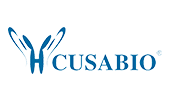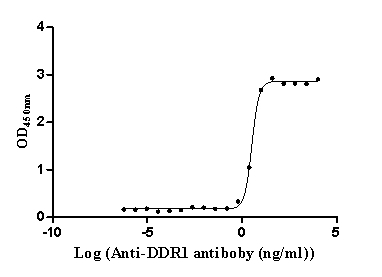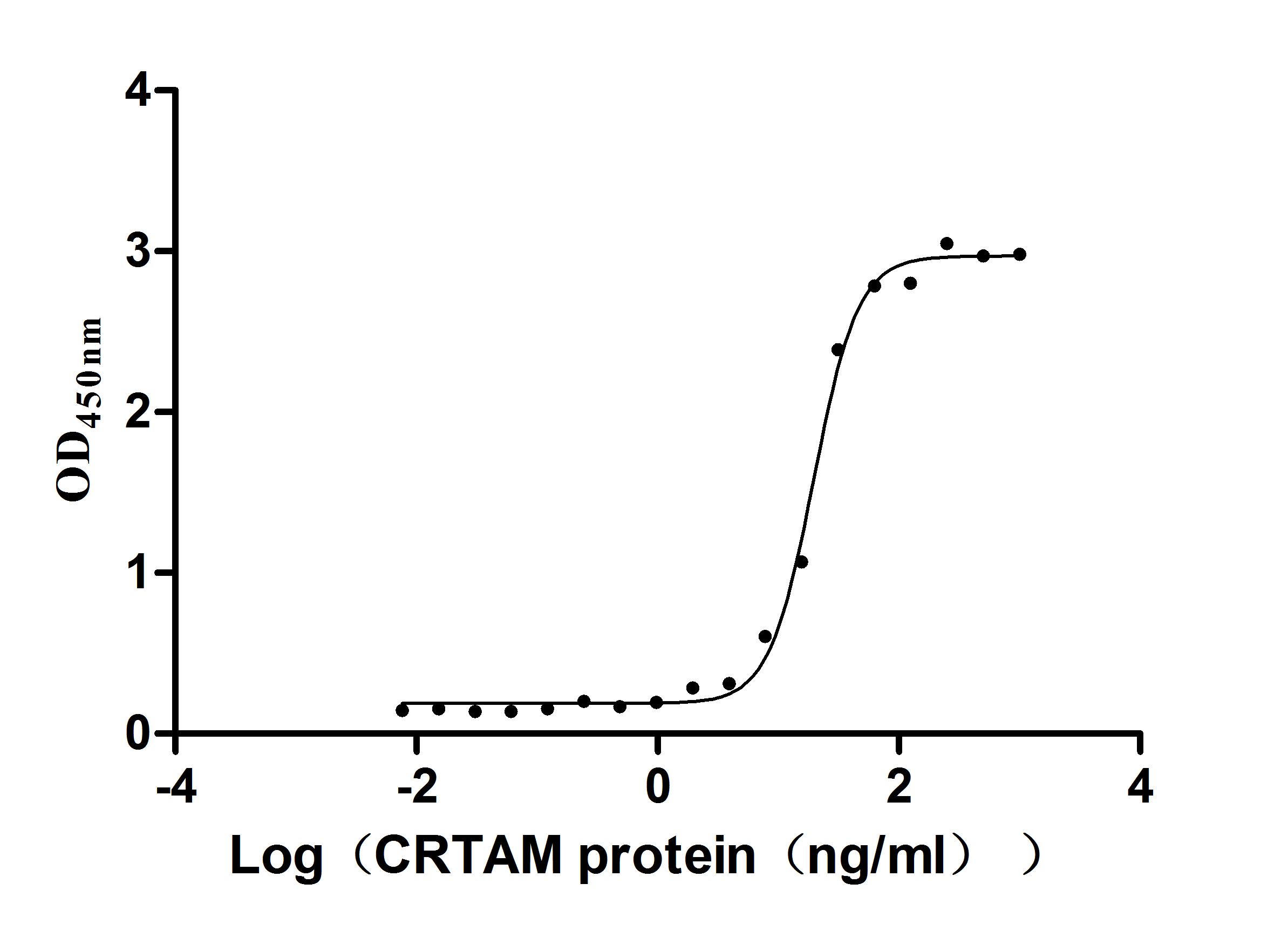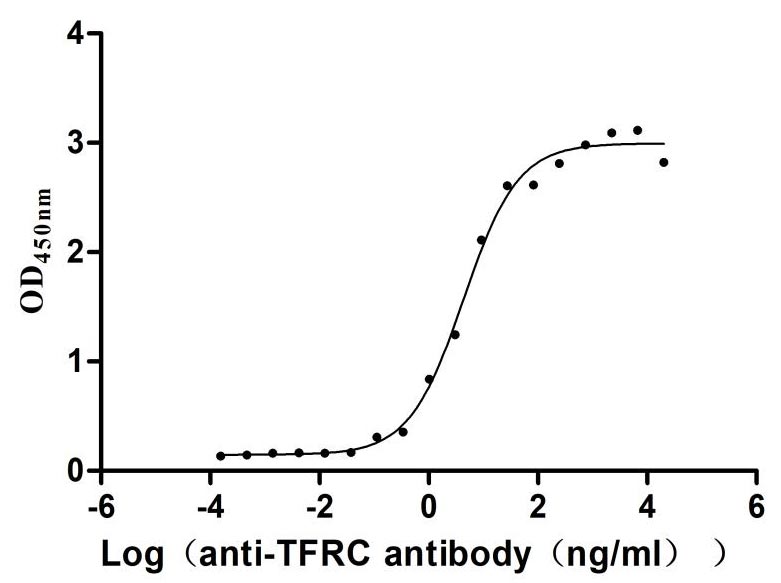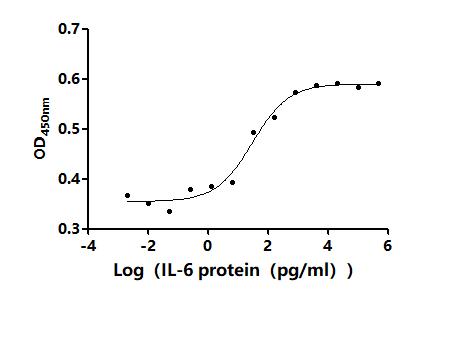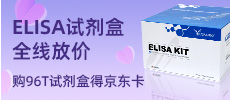Recombinant Human Sialoadhesin (SIGLEC1), partial
-
中文名称:人SIGLEC1重组蛋白
-
货号:CSB-YP887180HU
-
规格:
-
来源:Yeast
-
其他:
-
中文名称:人SIGLEC1重组蛋白
-
货号:CSB-EP887180HU
-
规格:
-
来源:E.coli
-
其他:
-
中文名称:人SIGLEC1重组蛋白
-
货号:CSB-EP887180HU-B
-
规格:
-
来源:E.coli
-
共轭:Avi-tag Biotinylated
E. coli biotin ligase (BirA) is highly specific in covalently attaching biotin to the 15 amino acid AviTag peptide. This recombinant protein was biotinylated in vivo by AviTag-BirA technology, which method is BriA catalyzes amide linkage between the biotin and the specific lysine of the AviTag.
-
其他:
-
中文名称:人SIGLEC1重组蛋白
-
货号:CSB-BP887180HU
-
规格:
-
来源:Baculovirus
-
其他:
-
中文名称:人SIGLEC1重组蛋白
-
货号:CSB-MP887180HU
-
规格:
-
来源:Mammalian cell
-
其他:
产品详情
-
纯度:>85% (SDS-PAGE)
-
基因名:SIGLEC1
-
Uniprot No.:
-
别名:CD169; CD169 antigen; dJ1009E24.1; DKFZp667F058; FLJ00051; FLJ00055; FLJ00073; FLJ00411; FLJ32150; Sialic acid binding Ig like lectin 1; sialic acid binding Ig-like lectin 1; sialoadhesin; Sialic acid binding immunoglobulin like lectin 1; Sialic acid-binding Ig-like lectin 1; Sialoadhesin; Siglec 1; Siglec-1; Siglec1; SN; SN_HUMAN
-
种属:Homo sapiens (Human)
-
蛋白长度:Partial
-
蛋白标签:Tag type will be determined during the manufacturing process.
The tag type will be determined during production process. If you have specified tag type, please tell us and we will develop the specified tag preferentially. -
产品提供形式:Lyophilized powder
Note: We will preferentially ship the format that we have in stock, however, if you have any special requirement for the format, please remark your requirement when placing the order, we will prepare according to your demand. -
复溶:We recommend that this vial be briefly centrifuged prior to opening to bring the contents to the bottom. Please reconstitute protein in deionized sterile water to a concentration of 0.1-1.0 mg/mL.We recommend to add 5-50% of glycerol (final concentration) and aliquot for long-term storage at -20℃/-80℃. Our default final concentration of glycerol is 50%. Customers could use it as reference.
-
储存条件:Store at -20°C/-80°C upon receipt, aliquoting is necessary for mutiple use. Avoid repeated freeze-thaw cycles.
-
保质期:The shelf life is related to many factors, storage state, buffer ingredients, storage temperature and the stability of the protein itself.
Generally, the shelf life of liquid form is 6 months at -20°C/-80°C. The shelf life of lyophilized form is 12 months at -20°C/-80°C. -
货期:Delivery time may differ from different purchasing way or location, please kindly consult your local distributors for specific delivery time.Note: All of our proteins are default shipped with normal blue ice packs, if you request to ship with dry ice, please communicate with us in advance and extra fees will be charged.
-
注意事项:Repeated freezing and thawing is not recommended. Store working aliquots at 4°C for up to one week.
-
Datasheet :Please contact us to get it.
相关产品
靶点详情
-
功能:Acts as an endocytic receptor mediating clathrin dependent endocytosis. Macrophage-restricted adhesion molecule that mediates sialic-acid dependent binding to lymphocytes, including granulocytes, monocytes, natural killer cells, B-cells and CD8 T-cells. Preferentially binds to alpha-2,3-linked sialic acid. Binds to SPN/CD43 on T-cells. May play a role in hemopoiesis.
-
基因功能参考文献:
- SIGLEC1 mRNA levels have potential as a novel predictive biomarker for Graves disease relapse. PMID: 29037117
- classical HIV-1 infectious routes may compensate for the lack of Siglec-1 in fuelling HIV-1 dissemination within infected individuals PMID: 27510803
- Our findings evidenced for the first time the novel association between SIGLEC1 rs3859664 SNP and active pulmonary TB. Intriguingly, carriers of the polymorphism produced less IL-1ss than non-carriers, suggesting the possible involvement of Siglec-1 signalling pathway with inflammasome complex. PMID: 28964857
- the antibody-sialidase conjugate desialylated tumor cells in a HER2-dependent manner, reduced binding by natural killer (NK) cell inhibitory sialic acid-binding Ig-like lectin (Siglec) receptors, and enhanced binding to the NK-activating receptor natural killer group 2D (NKG2D). PMID: 27551071
- The results reveal marked differences between afferent and efferent ymphatic endothelial cells and identify molecules on lymphatic vessels. Further characterizations of Siglec-1 (CD169) and macrophage scavenger receptor 1 (MSR1/CD204), show that they are discriminatively expressed on lymphatic endothelium of the subcapsular sinus but not on lymphatic vasculature of the lymphatic sinus PMID: 27601677
- High CD169 expression is associated with HIV-1. PMID: 28794041
- CD169 expression in regional LNs was not associated with PSA-relapse. PMID: 28880401
- These results highlight the importance of sialic acids on the V1V2 region in binding to sialic acid-binding immunoglobulin-like lectin. PMID: 26667473
- High expression of SIGLEC1 in pregnant women with autoantibodies against Ro/SS-A indicates an enhanced risk for autoimmune congenital heart block development. PMID: 28501799
- These data demonstrate a prominent role for Siglec-1 in the internalization of HIV-1 to the virus-containing compartment in infected monocyte-derived macrophages PMID: 28129379
- this study shows that binding of monoclonal antibodies to Sn results in delayed and reduced phagocytosis of fluorescent beads, and that no effect is observed on Fc-mediated phagocytosis or phagocytosis of bacteria by macrophages PMID: 27993350
- These findings suggest that CD169+ macrophages in RLNs might be a useful marker for assessing clinical stage, including LN states, in patients with breast cancer. PMID: 27861544
- CD169 might act as a co-stimulatory molecule for cytotoxic T-cell activation, and could define a population of tumour-infiltrating macrophages with potential anti-tumour properties in human hepatocellular carcinoma tissues. PMID: 27174787
- In colorectal tumor, malignant melanoma, and endometrial tumor, it was shown that a high density of CD169-positive macrophages in the lymph node sinus was a predictive factor for better clinical prognosis. PMID: 28002629
- Siglec-1 and Siglec-2 are potential biomarkers in autoimmune disease. (Review) PMID: 26752092
- Siglec-1 on myeloid cells could fuel novel CD4(+) T-cell infections and contribute to HIV-1 dissemination in vivo. PMID: 25947229
- evidence identifying sialyllactose-containing gangliosides in the viral membrane and the cellular lectin Siglec-1 as critical determinants for HIV-1 capture and storage by mature DCs and for DC-mediated trans-infection of T cells PMID: 25033082
- Our study suggests that HIV-1 capture by CD169 can provide virus evasion from both innate (phagocytosis) and adaptive immune responses PMID: 25760631
- GM3-CD169 binding is a gp120-independent signal for sequestration and preservation of HIV-1 infectivity. PMID: 24947940
- The most abundant cytokine present in semen (TGF-beta1) is able to enhance specifically the expression of an important molecule (CD169) involved in the capture and transmission of HIV-1 particles from the mucosal lumen to the submucosal compartment. PMID: 25354152
- Siglec-1 may play a proinflammatory role in stimulating lymphocyte proliferation and activation in rheumatoid arthritis. PMID: 24196391
- CD169(+) macrophages in RLNs promote CD8(+) T-cell-mediated antitumor immunity. PMID: 23734742
- downregulation of CD169 expression or neutralizing CD169 function abrogated dendritic cell-mediated HIV-1 capture and trans infection, while exogenous expression of CD169 in receptor-naive cells rescued glycosphingolipid-dependent capture and trans infection. PMID: 23593001
- Based on increased SIGLEC1 expression in circulating monocytes, findings suggest a role for SIGLEC1 in the chronic progressive phases of multiple sclerosis. PMID: 22933622
- the CD169/Sn endocytic pathway is conserved and capable of presenting lipid antigens to iNKT cells PMID: 23610394
- These findings identify Siglec-1 as a key factor for HIV-1 spread via infectious dendritic/T-cell synapses. PMID: 23271952
- Monocytes overexpress sialoadhesin nonspecifically during intestinal transplant rejection and systemic or enteritic inflammatory states. PMID: 22249367
- Increased expression in monocytes of patients with primary biliary cirrhosis PMID: 20653431
- Sialoadhesin is induced to high levels on CD14(+) cells early after HIV-1 infection in vivo. PMID: 17330143
- Data show that the combinatorial signal delivered by R-DC to T cells via B7-H1 and sialoadhesin is crucial for the induction of IL-35(+) Treg. PMID: 19950173
- Inhibitory signals delivered from human rhinovirus HRV14-treated dendritic cells to cocultured T cells via sialoadhesin (Sn) are critical for induction of T-cell anergy. PMID: 16002716
- Increased expression of Siglec-1 in circulating systemic sclerosis (SSc) monocytes and tissue macrophages suggests type I IFN-mediated activation of monocytes occurs in SSc, possibly through toll-like receptor (TLR) activation of interferon secretion. PMID: 17328080
- Siglec-1 (sialic acid binding Ig-like lectin 1) expression in resident blood monocytes is a potential biomarker for monitoring disease activity, displaying type I IFN responses, and estimating levels of anti-dsDNA antibodies PMID: 18383365
- Increased sialoadhesin expression on CD14(+) monocytes occurs in response to HIV-1 infection with maximum expression associated with high viral load PMID: 18414664
- Siglec-1 may be considered as a potential non-invasive indicator for monitoring disease severity and a biomarker for predicting the relative risk of cardiovascular events. PMID: 19285973
- SIGLEC1, used as a surrogate marker for type I interferon, is a potential biomarker to assess disease acitvity in systemic lupus erythematosus (SLE). SIGLEC1+ resident monocytes could act as antigen presenting cells in SLE. PMID: 18383365
显示更多
收起更多
-
亚细胞定位:[Isoform 1]: Cell membrane; Single-pass type I membrane protein.; [Isoform 2]: Secreted.
-
蛋白家族:Immunoglobulin superfamily, SIGLEC (sialic acid binding Ig-like lectin) family
-
组织特异性:Expressed by macrophages in various tissues. High levels are found in spleen, lymph node, perivascular macrophages in brain and lower levels in bone marrow, liver Kupffer cells and lamina propria of colon and lung. Also expressed by inflammatory macrophag
-
数据库链接:
Most popular with customers
-
Recombinant Human ICOS ligand (ICOSLG), partial (Active)
Express system: Mammalian cell
Species: Homo sapiens (Human)
-
Recombinant Human Plexin-B1 (PLXNB1), partial (Active)
Express system: Mammalian cell
Species: Homo sapiens (Human)
-
Recombinant Human Poliovirus receptor (PVR) (I340M), partial (Active)
Express system: Mammalian cell
Species: Homo sapiens (Human)
-
Recombinant Rat Intestinal-type alkaline phosphatase 1 (Alpi) (Active)
Express system: Mammalian cell
Species: Rattus norvegicus (Rat)
-
Recombinant Human Epithelial discoidin domain-containing receptor 1 (DDR1), partial (Active)
Express system: Mammalian cell
Species: Homo sapiens (Human)
-
Recombinant Human Cell adhesion molecule 1 (CADM1), partial (Active)
Express system: Mammalian cell
Species: Homo sapiens (Human)
-
Recombinant Human Transferrin receptor protein 1 (TFRC), partial (Active)
Express system: Mammalian cell
Species: Homo sapiens (Human)
-


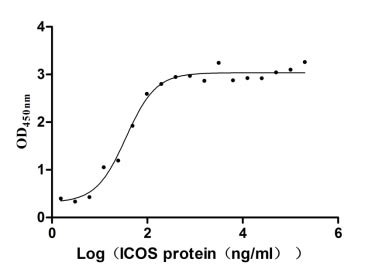
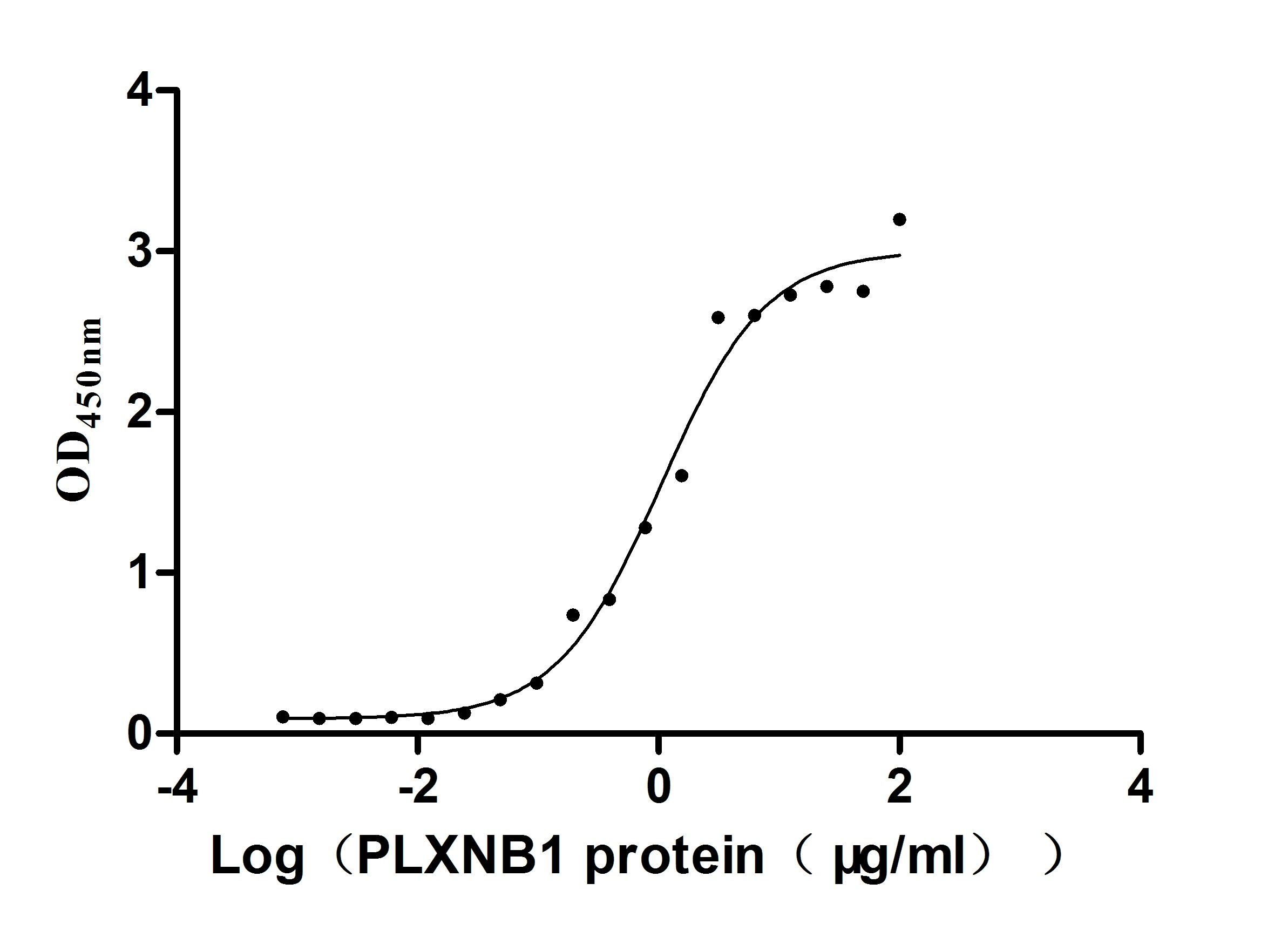
-AC1.jpg)
